Detailed Analysis of Impairment Loss Accounting Based on AASB 136
VerifiedAdded on 2019/10/30
|8
|1587
|198
Report
AI Summary
This report provides a comprehensive analysis of impairment loss accounting in accordance with AASB 136, the Australian Accounting Standard related to the impairment of assets. It defines key concepts such as carrying amount, recoverable amount, and fair value, explaining how to recognize and measure impairment losses for individual assets. The report outlines the procedures for calculating impairment loss, including the comparison of carrying amount with recoverable amount. It also covers the recognition of impairment loss in the profit and loss account and the adjustments required for revalued assets. Additionally, the report includes a practical example demonstrating the calculation of impairment loss and journal entries. The report also provides a detailed case study of a company's impairment loss allocation across different asset categories, including goodwill, plant, equipment, and fittings. It details the journal entries, and the allocation of impairment losses, and references relevant accounting standards and academic literature.
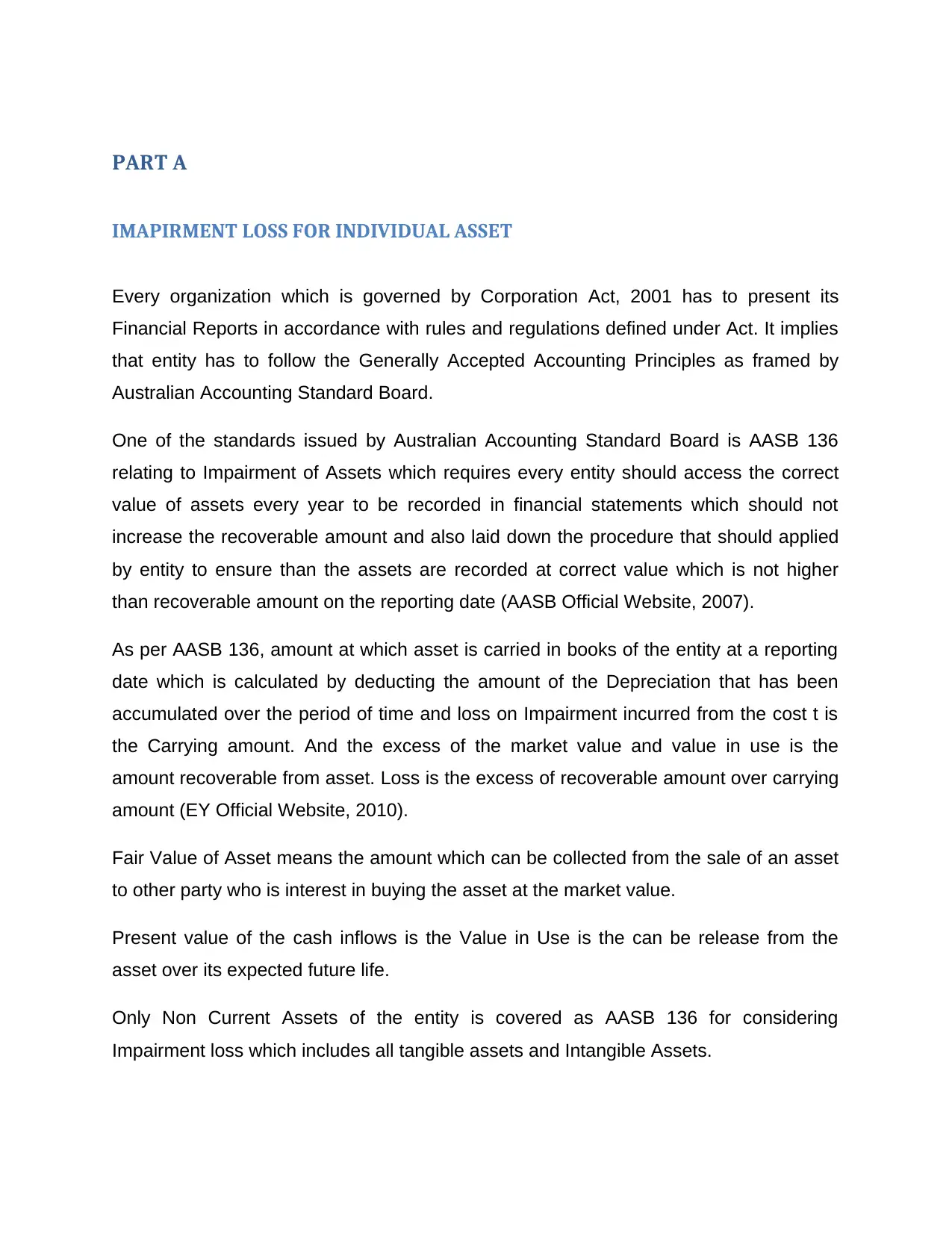
PART A
IMAPIRMENT LOSS FOR INDIVIDUAL ASSET
Every organization which is governed by Corporation Act, 2001 has to present its
Financial Reports in accordance with rules and regulations defined under Act. It implies
that entity has to follow the Generally Accepted Accounting Principles as framed by
Australian Accounting Standard Board.
One of the standards issued by Australian Accounting Standard Board is AASB 136
relating to Impairment of Assets which requires every entity should access the correct
value of assets every year to be recorded in financial statements which should not
increase the recoverable amount and also laid down the procedure that should applied
by entity to ensure than the assets are recorded at correct value which is not higher
than recoverable amount on the reporting date (AASB Official Website, 2007).
As per AASB 136, amount at which asset is carried in books of the entity at a reporting
date which is calculated by deducting the amount of the Depreciation that has been
accumulated over the period of time and loss on Impairment incurred from the cost t is
the Carrying amount. And the excess of the market value and value in use is the
amount recoverable from asset. Loss is the excess of recoverable amount over carrying
amount (EY Official Website, 2010).
Fair Value of Asset means the amount which can be collected from the sale of an asset
to other party who is interest in buying the asset at the market value.
Present value of the cash inflows is the Value in Use is the can be release from the
asset over its expected future life.
Only Non Current Assets of the entity is covered as AASB 136 for considering
Impairment loss which includes all tangible assets and Intangible Assets.
IMAPIRMENT LOSS FOR INDIVIDUAL ASSET
Every organization which is governed by Corporation Act, 2001 has to present its
Financial Reports in accordance with rules and regulations defined under Act. It implies
that entity has to follow the Generally Accepted Accounting Principles as framed by
Australian Accounting Standard Board.
One of the standards issued by Australian Accounting Standard Board is AASB 136
relating to Impairment of Assets which requires every entity should access the correct
value of assets every year to be recorded in financial statements which should not
increase the recoverable amount and also laid down the procedure that should applied
by entity to ensure than the assets are recorded at correct value which is not higher
than recoverable amount on the reporting date (AASB Official Website, 2007).
As per AASB 136, amount at which asset is carried in books of the entity at a reporting
date which is calculated by deducting the amount of the Depreciation that has been
accumulated over the period of time and loss on Impairment incurred from the cost t is
the Carrying amount. And the excess of the market value and value in use is the
amount recoverable from asset. Loss is the excess of recoverable amount over carrying
amount (EY Official Website, 2010).
Fair Value of Asset means the amount which can be collected from the sale of an asset
to other party who is interest in buying the asset at the market value.
Present value of the cash inflows is the Value in Use is the can be release from the
asset over its expected future life.
Only Non Current Assets of the entity is covered as AASB 136 for considering
Impairment loss which includes all tangible assets and Intangible Assets.
Paraphrase This Document
Need a fresh take? Get an instant paraphrase of this document with our AI Paraphraser
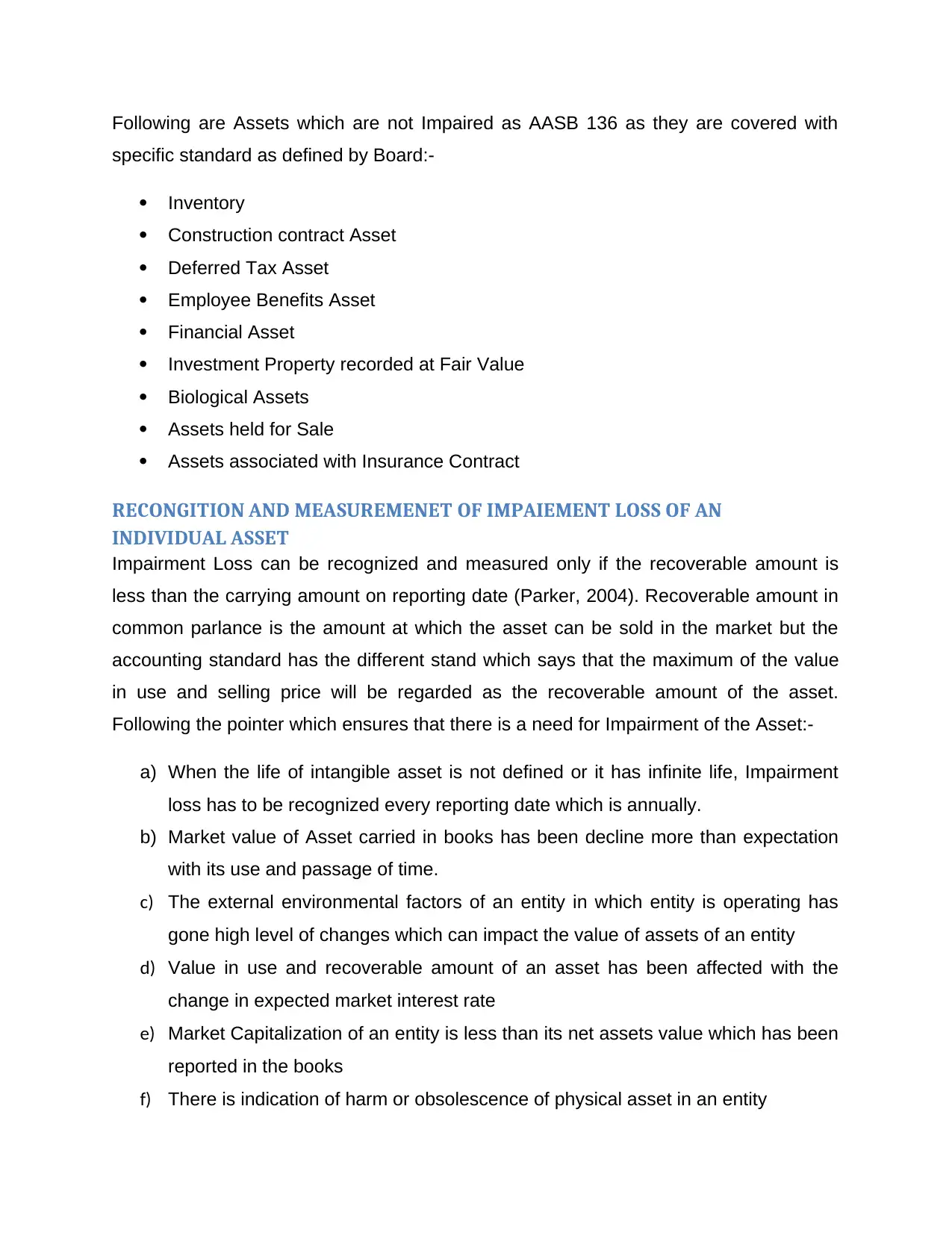
Following are Assets which are not Impaired as AASB 136 as they are covered with
specific standard as defined by Board:-
Inventory
Construction contract Asset
Deferred Tax Asset
Employee Benefits Asset
Financial Asset
Investment Property recorded at Fair Value
Biological Assets
Assets held for Sale
Assets associated with Insurance Contract
RECONGITION AND MEASUREMENET OF IMPAIEMENT LOSS OF AN
INDIVIDUAL ASSET
Impairment Loss can be recognized and measured only if the recoverable amount is
less than the carrying amount on reporting date (Parker, 2004). Recoverable amount in
common parlance is the amount at which the asset can be sold in the market but the
accounting standard has the different stand which says that the maximum of the value
in use and selling price will be regarded as the recoverable amount of the asset.
Following the pointer which ensures that there is a need for Impairment of the Asset:-
a) When the life of intangible asset is not defined or it has infinite life, Impairment
loss has to be recognized every reporting date which is annually.
b) Market value of Asset carried in books has been decline more than expectation
with its use and passage of time.
c) The external environmental factors of an entity in which entity is operating has
gone high level of changes which can impact the value of assets of an entity
d) Value in use and recoverable amount of an asset has been affected with the
change in expected market interest rate
e) Market Capitalization of an entity is less than its net assets value which has been
reported in the books
f) There is indication of harm or obsolescence of physical asset in an entity
specific standard as defined by Board:-
Inventory
Construction contract Asset
Deferred Tax Asset
Employee Benefits Asset
Financial Asset
Investment Property recorded at Fair Value
Biological Assets
Assets held for Sale
Assets associated with Insurance Contract
RECONGITION AND MEASUREMENET OF IMPAIEMENT LOSS OF AN
INDIVIDUAL ASSET
Impairment Loss can be recognized and measured only if the recoverable amount is
less than the carrying amount on reporting date (Parker, 2004). Recoverable amount in
common parlance is the amount at which the asset can be sold in the market but the
accounting standard has the different stand which says that the maximum of the value
in use and selling price will be regarded as the recoverable amount of the asset.
Following the pointer which ensures that there is a need for Impairment of the Asset:-
a) When the life of intangible asset is not defined or it has infinite life, Impairment
loss has to be recognized every reporting date which is annually.
b) Market value of Asset carried in books has been decline more than expectation
with its use and passage of time.
c) The external environmental factors of an entity in which entity is operating has
gone high level of changes which can impact the value of assets of an entity
d) Value in use and recoverable amount of an asset has been affected with the
change in expected market interest rate
e) Market Capitalization of an entity is less than its net assets value which has been
reported in the books
f) There is indication of harm or obsolescence of physical asset in an entity
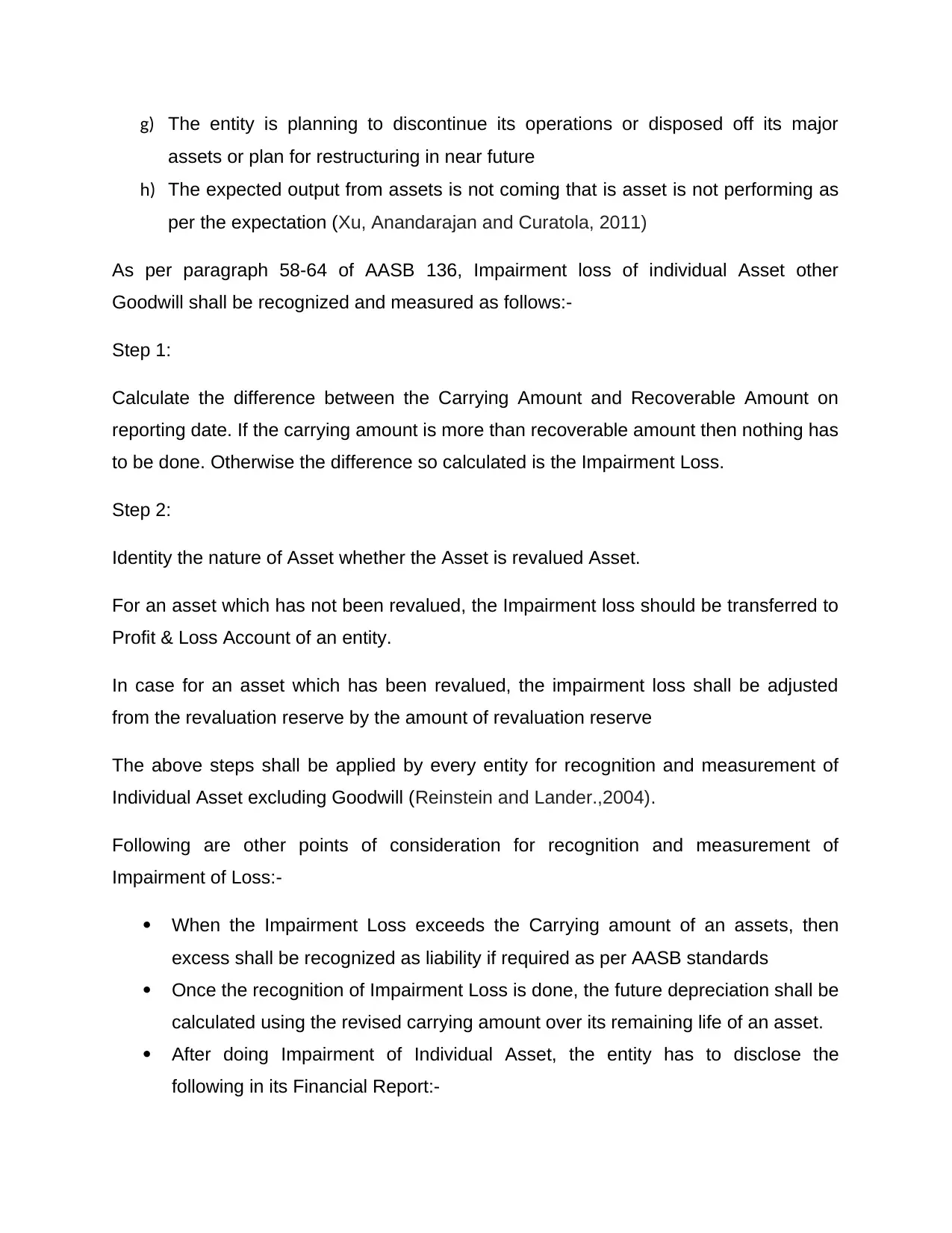
g) The entity is planning to discontinue its operations or disposed off its major
assets or plan for restructuring in near future
h) The expected output from assets is not coming that is asset is not performing as
per the expectation (Xu, Anandarajan and Curatola, 2011)
As per paragraph 58-64 of AASB 136, Impairment loss of individual Asset other
Goodwill shall be recognized and measured as follows:-
Step 1:
Calculate the difference between the Carrying Amount and Recoverable Amount on
reporting date. If the carrying amount is more than recoverable amount then nothing has
to be done. Otherwise the difference so calculated is the Impairment Loss.
Step 2:
Identity the nature of Asset whether the Asset is revalued Asset.
For an asset which has not been revalued, the Impairment loss should be transferred to
Profit & Loss Account of an entity.
In case for an asset which has been revalued, the impairment loss shall be adjusted
from the revaluation reserve by the amount of revaluation reserve
The above steps shall be applied by every entity for recognition and measurement of
Individual Asset excluding Goodwill (Reinstein and Lander.,2004).
Following are other points of consideration for recognition and measurement of
Impairment of Loss:-
When the Impairment Loss exceeds the Carrying amount of an assets, then
excess shall be recognized as liability if required as per AASB standards
Once the recognition of Impairment Loss is done, the future depreciation shall be
calculated using the revised carrying amount over its remaining life of an asset.
After doing Impairment of Individual Asset, the entity has to disclose the
following in its Financial Report:-
assets or plan for restructuring in near future
h) The expected output from assets is not coming that is asset is not performing as
per the expectation (Xu, Anandarajan and Curatola, 2011)
As per paragraph 58-64 of AASB 136, Impairment loss of individual Asset other
Goodwill shall be recognized and measured as follows:-
Step 1:
Calculate the difference between the Carrying Amount and Recoverable Amount on
reporting date. If the carrying amount is more than recoverable amount then nothing has
to be done. Otherwise the difference so calculated is the Impairment Loss.
Step 2:
Identity the nature of Asset whether the Asset is revalued Asset.
For an asset which has not been revalued, the Impairment loss should be transferred to
Profit & Loss Account of an entity.
In case for an asset which has been revalued, the impairment loss shall be adjusted
from the revaluation reserve by the amount of revaluation reserve
The above steps shall be applied by every entity for recognition and measurement of
Individual Asset excluding Goodwill (Reinstein and Lander.,2004).
Following are other points of consideration for recognition and measurement of
Impairment of Loss:-
When the Impairment Loss exceeds the Carrying amount of an assets, then
excess shall be recognized as liability if required as per AASB standards
Once the recognition of Impairment Loss is done, the future depreciation shall be
calculated using the revised carrying amount over its remaining life of an asset.
After doing Impairment of Individual Asset, the entity has to disclose the
following in its Financial Report:-
⊘ This is a preview!⊘
Do you want full access?
Subscribe today to unlock all pages.

Trusted by 1+ million students worldwide
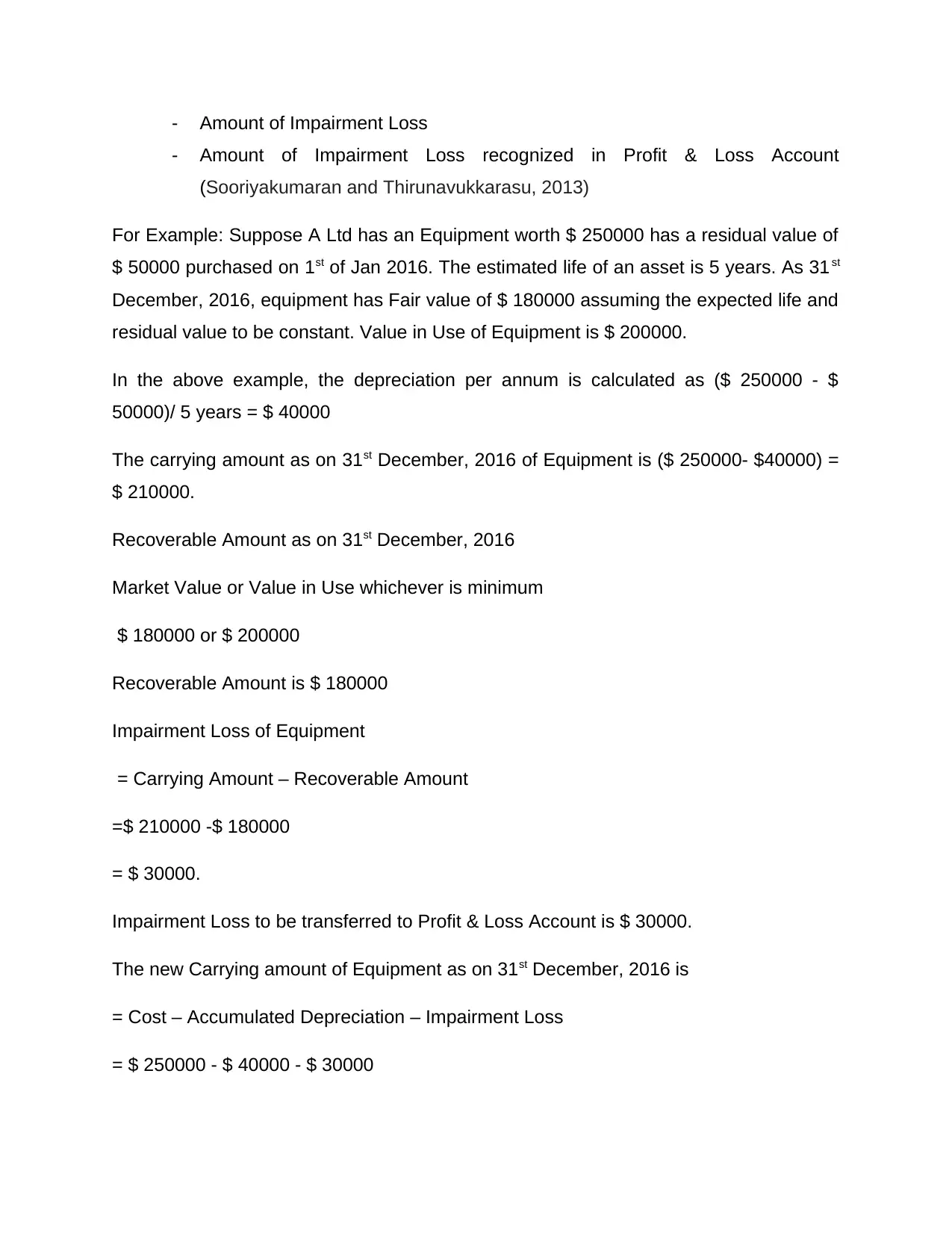
- Amount of Impairment Loss
- Amount of Impairment Loss recognized in Profit & Loss Account
(Sooriyakumaran and Thirunavukkarasu, 2013)
For Example: Suppose A Ltd has an Equipment worth $ 250000 has a residual value of
$ 50000 purchased on 1st of Jan 2016. The estimated life of an asset is 5 years. As 31 st
December, 2016, equipment has Fair value of $ 180000 assuming the expected life and
residual value to be constant. Value in Use of Equipment is $ 200000.
In the above example, the depreciation per annum is calculated as ($ 250000 - $
50000)/ 5 years = $ 40000
The carrying amount as on 31st December, 2016 of Equipment is ($ 250000- $40000) =
$ 210000.
Recoverable Amount as on 31st December, 2016
Market Value or Value in Use whichever is minimum
$ 180000 or $ 200000
Recoverable Amount is $ 180000
Impairment Loss of Equipment
= Carrying Amount – Recoverable Amount
=$ 210000 -$ 180000
= $ 30000.
Impairment Loss to be transferred to Profit & Loss Account is $ 30000.
The new Carrying amount of Equipment as on 31st December, 2016 is
= Cost – Accumulated Depreciation – Impairment Loss
= $ 250000 - $ 40000 - $ 30000
- Amount of Impairment Loss recognized in Profit & Loss Account
(Sooriyakumaran and Thirunavukkarasu, 2013)
For Example: Suppose A Ltd has an Equipment worth $ 250000 has a residual value of
$ 50000 purchased on 1st of Jan 2016. The estimated life of an asset is 5 years. As 31 st
December, 2016, equipment has Fair value of $ 180000 assuming the expected life and
residual value to be constant. Value in Use of Equipment is $ 200000.
In the above example, the depreciation per annum is calculated as ($ 250000 - $
50000)/ 5 years = $ 40000
The carrying amount as on 31st December, 2016 of Equipment is ($ 250000- $40000) =
$ 210000.
Recoverable Amount as on 31st December, 2016
Market Value or Value in Use whichever is minimum
$ 180000 or $ 200000
Recoverable Amount is $ 180000
Impairment Loss of Equipment
= Carrying Amount – Recoverable Amount
=$ 210000 -$ 180000
= $ 30000.
Impairment Loss to be transferred to Profit & Loss Account is $ 30000.
The new Carrying amount of Equipment as on 31st December, 2016 is
= Cost – Accumulated Depreciation – Impairment Loss
= $ 250000 - $ 40000 - $ 30000
Paraphrase This Document
Need a fresh take? Get an instant paraphrase of this document with our AI Paraphraser

= $ 180000
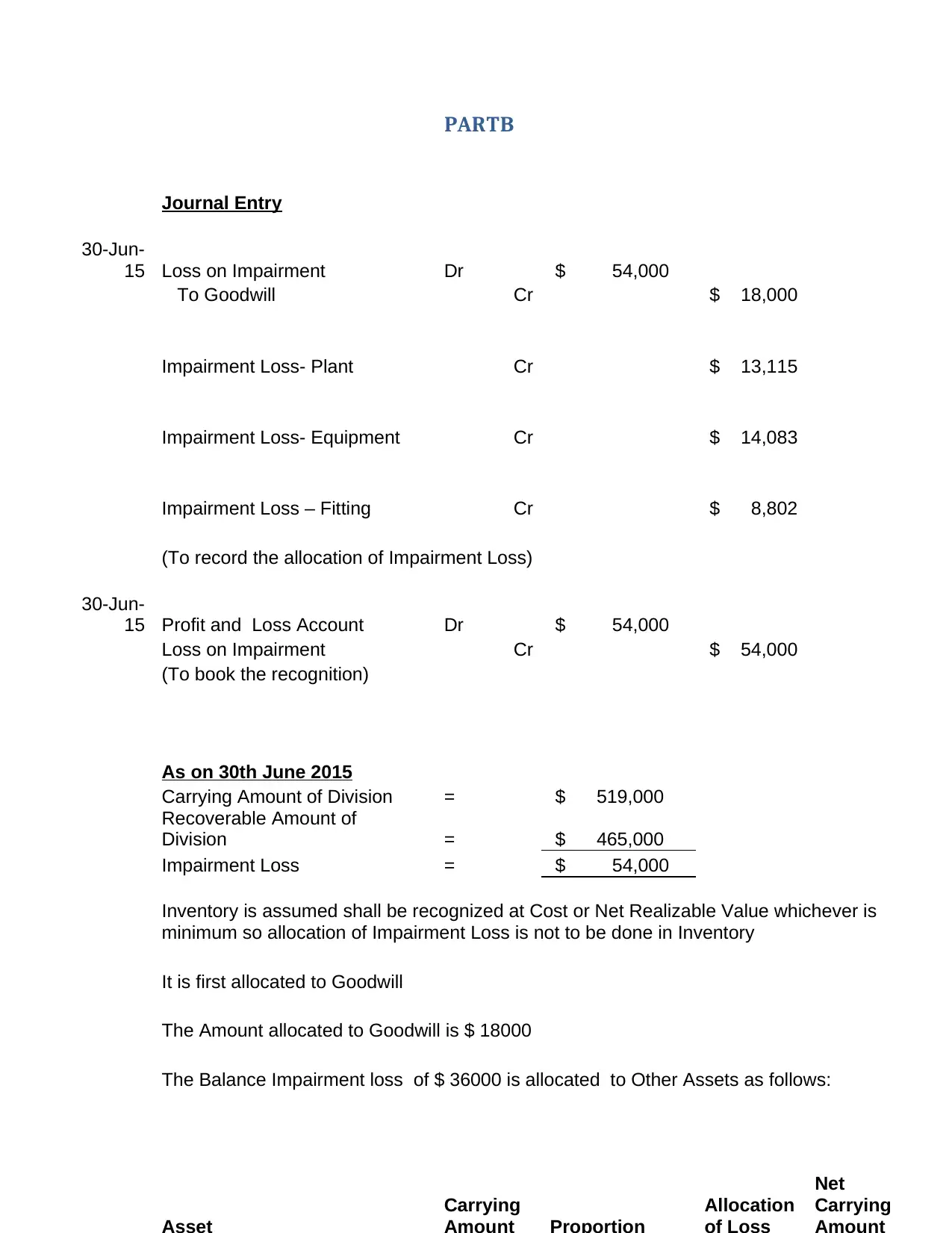
PARTB
Journal Entry
30-Jun-
15 Loss on Impairment Dr $ 54,000
To Goodwill Cr $ 18,000
Impairment Loss- Plant Cr $ 13,115
Impairment Loss- Equipment Cr $ 14,083
Impairment Loss – Fitting Cr $ 8,802
(To record the allocation of Impairment Loss)
30-Jun-
15 Profit and Loss Account Dr $ 54,000
Loss on Impairment Cr $ 54,000
(To book the recognition)
As on 30th June 2015
Carrying Amount of Division = $ 519,000
Recoverable Amount of
Division = $ 465,000
Impairment Loss = $ 54,000
Inventory is assumed shall be recognized at Cost or Net Realizable Value whichever is
minimum so allocation of Impairment Loss is not to be done in Inventory
It is first allocated to Goodwill
The Amount allocated to Goodwill is $ 18000
The Balance Impairment loss of $ 36000 is allocated to Other Assets as follows:
Carrying Allocation
Net
Carrying
Journal Entry
30-Jun-
15 Loss on Impairment Dr $ 54,000
To Goodwill Cr $ 18,000
Impairment Loss- Plant Cr $ 13,115
Impairment Loss- Equipment Cr $ 14,083
Impairment Loss – Fitting Cr $ 8,802
(To record the allocation of Impairment Loss)
30-Jun-
15 Profit and Loss Account Dr $ 54,000
Loss on Impairment Cr $ 54,000
(To book the recognition)
As on 30th June 2015
Carrying Amount of Division = $ 519,000
Recoverable Amount of
Division = $ 465,000
Impairment Loss = $ 54,000
Inventory is assumed shall be recognized at Cost or Net Realizable Value whichever is
minimum so allocation of Impairment Loss is not to be done in Inventory
It is first allocated to Goodwill
The Amount allocated to Goodwill is $ 18000
The Balance Impairment loss of $ 36000 is allocated to Other Assets as follows:
Carrying Allocation
Net
Carrying
⊘ This is a preview!⊘
Do you want full access?
Subscribe today to unlock all pages.

Trusted by 1+ million students worldwide
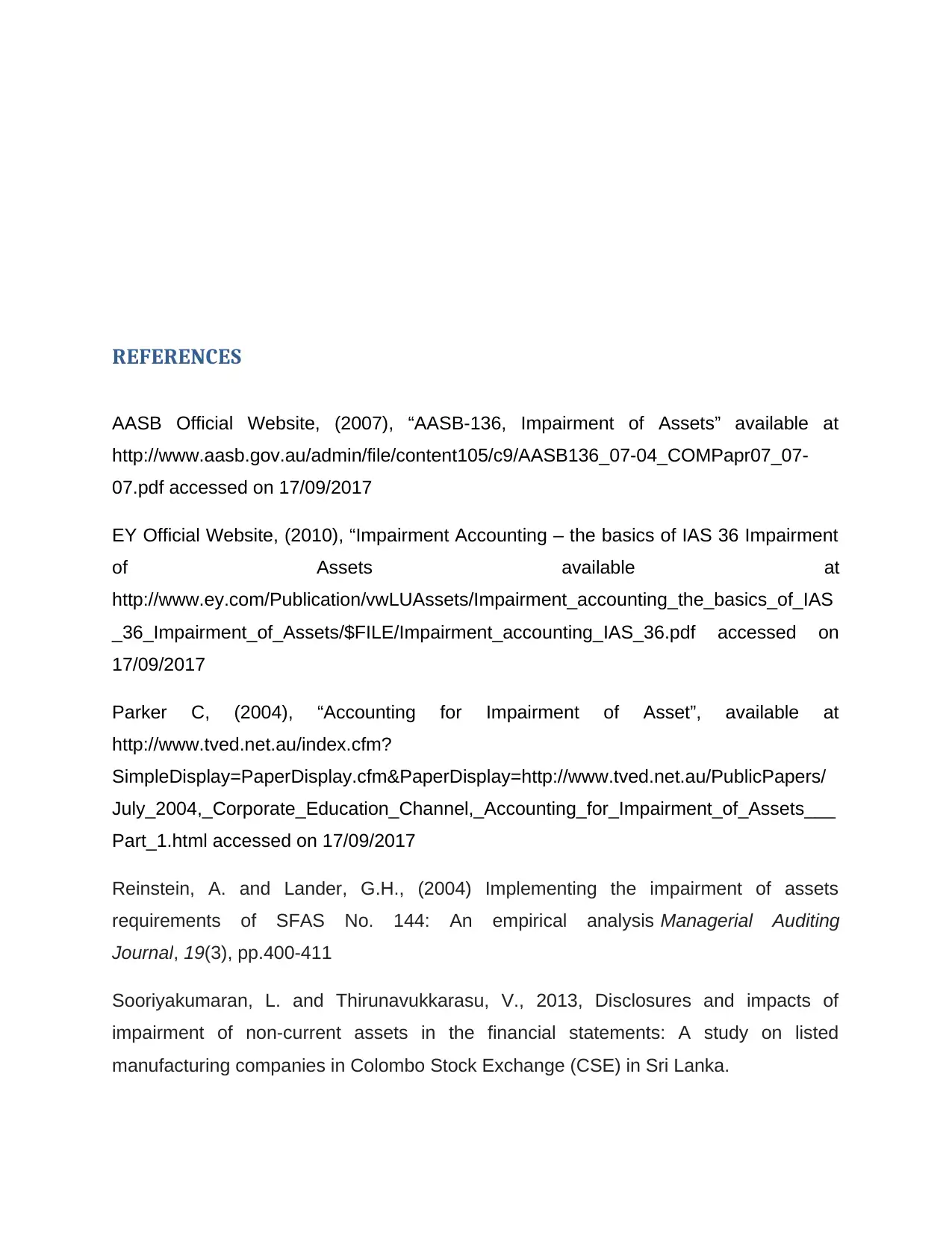
REFERENCES
AASB Official Website, (2007), “AASB-136, Impairment of Assets” available at
http://www.aasb.gov.au/admin/file/content105/c9/AASB136_07-04_COMPapr07_07-
07.pdf accessed on 17/09/2017
EY Official Website, (2010), “Impairment Accounting – the basics of IAS 36 Impairment
of Assets available at
http://www.ey.com/Publication/vwLUAssets/Impairment_accounting_the_basics_of_IAS
_36_Impairment_of_Assets/$FILE/Impairment_accounting_IAS_36.pdf accessed on
17/09/2017
Parker C, (2004), “Accounting for Impairment of Asset”, available at
http://www.tved.net.au/index.cfm?
SimpleDisplay=PaperDisplay.cfm&PaperDisplay=http://www.tved.net.au/PublicPapers/
July_2004,_Corporate_Education_Channel,_Accounting_for_Impairment_of_Assets___
Part_1.html accessed on 17/09/2017
Reinstein, A. and Lander, G.H., (2004) Implementing the impairment of assets
requirements of SFAS No. 144: An empirical analysis Managerial Auditing
Journal, 19(3), pp.400-411
Sooriyakumaran, L. and Thirunavukkarasu, V., 2013, Disclosures and impacts of
impairment of non-current assets in the financial statements: A study on listed
manufacturing companies in Colombo Stock Exchange (CSE) in Sri Lanka.
AASB Official Website, (2007), “AASB-136, Impairment of Assets” available at
http://www.aasb.gov.au/admin/file/content105/c9/AASB136_07-04_COMPapr07_07-
07.pdf accessed on 17/09/2017
EY Official Website, (2010), “Impairment Accounting – the basics of IAS 36 Impairment
of Assets available at
http://www.ey.com/Publication/vwLUAssets/Impairment_accounting_the_basics_of_IAS
_36_Impairment_of_Assets/$FILE/Impairment_accounting_IAS_36.pdf accessed on
17/09/2017
Parker C, (2004), “Accounting for Impairment of Asset”, available at
http://www.tved.net.au/index.cfm?
SimpleDisplay=PaperDisplay.cfm&PaperDisplay=http://www.tved.net.au/PublicPapers/
July_2004,_Corporate_Education_Channel,_Accounting_for_Impairment_of_Assets___
Part_1.html accessed on 17/09/2017
Reinstein, A. and Lander, G.H., (2004) Implementing the impairment of assets
requirements of SFAS No. 144: An empirical analysis Managerial Auditing
Journal, 19(3), pp.400-411
Sooriyakumaran, L. and Thirunavukkarasu, V., 2013, Disclosures and impacts of
impairment of non-current assets in the financial statements: A study on listed
manufacturing companies in Colombo Stock Exchange (CSE) in Sri Lanka.
Paraphrase This Document
Need a fresh take? Get an instant paraphrase of this document with our AI Paraphraser
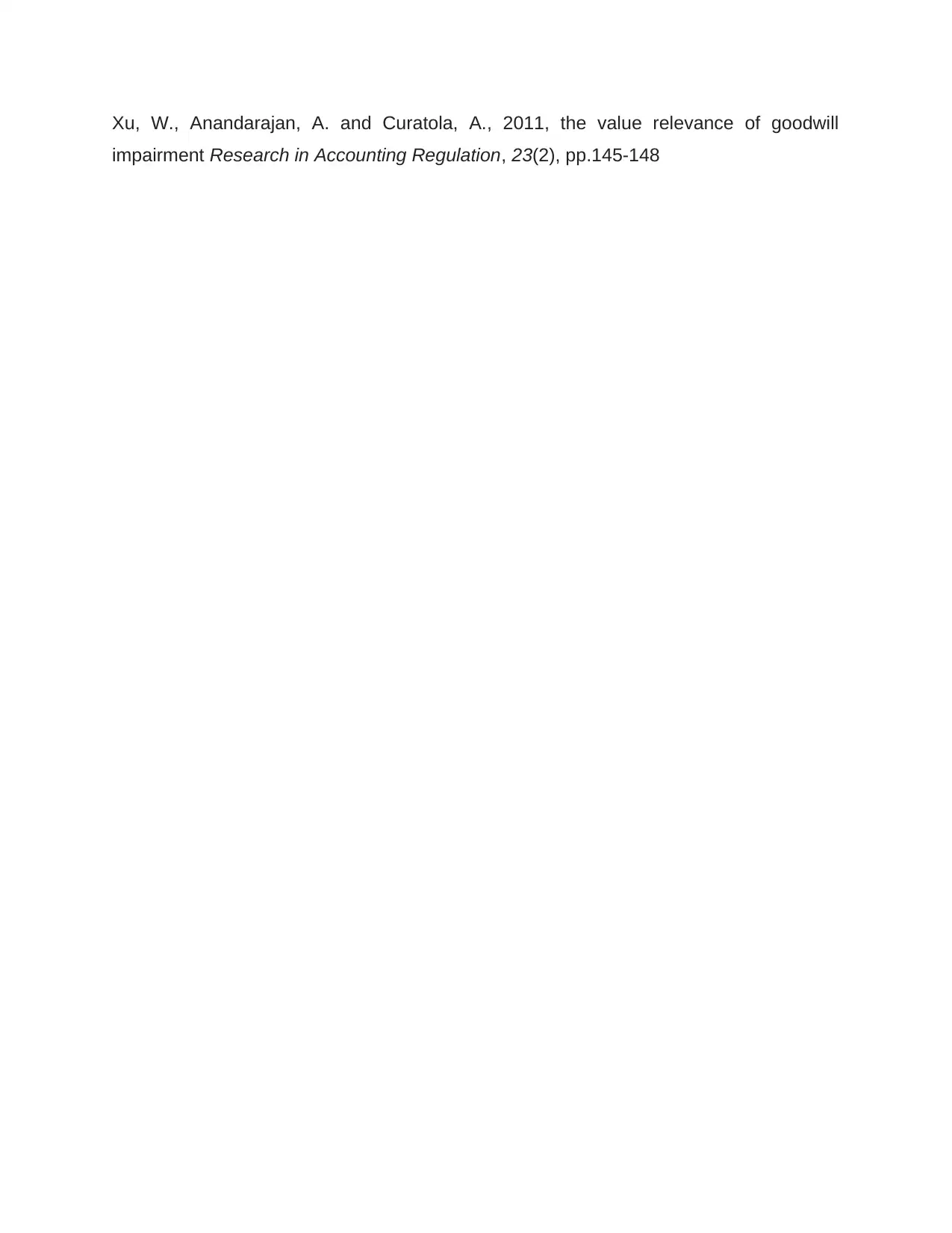
Xu, W., Anandarajan, A. and Curatola, A., 2011, the value relevance of goodwill
impairment Research in Accounting Regulation, 23(2), pp.145-148
impairment Research in Accounting Regulation, 23(2), pp.145-148
1 out of 8
Related Documents
Your All-in-One AI-Powered Toolkit for Academic Success.
+13062052269
info@desklib.com
Available 24*7 on WhatsApp / Email
![[object Object]](/_next/static/media/star-bottom.7253800d.svg)
Unlock your academic potential
Copyright © 2020–2025 A2Z Services. All Rights Reserved. Developed and managed by ZUCOL.




